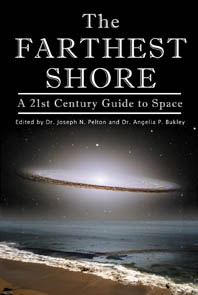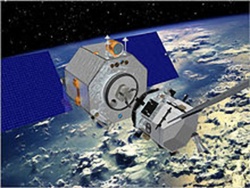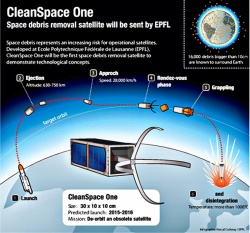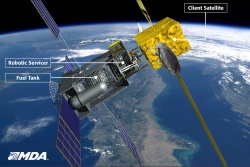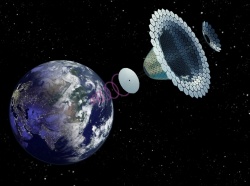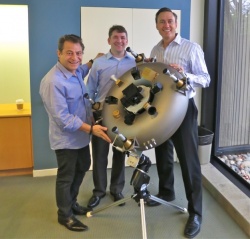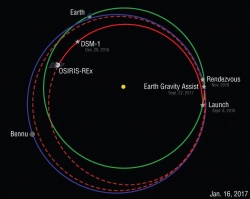The Farthest Shore – Chapter Thirteen New Space Services and Industries
From The Space Library
Chapter Thirteen New Space Services and Industries
Joseph N. Pelton, Michael Potter and Chris Stott
There has been in the past decade a sea change in the world of space. The final grounding of the space shuttle fleet and the sudden rise of the so-called “New Space” private entrepreneurial activities has served to transform today’s world of space activities. chapter 14, that immediately follows, addresses the important new world of commercial space launchers and its spur to innovative design, lowered launch costs, and its impact on satellite system design such as the increase in space satellite deployment and plans for large scale satellite constellations. Beyond new launch vehicle innovation and the small satellite revolution, there has also been--in many ways in response to New Space driven new launch capabilities-- the parallel growth of a number of new space industries that give promise of a whole new space economy.[1]
The unfolding of new space services is currently unfolding at amazing speed. There are now several new commercial ventures that would undertake to perform a variety of on-orbit servicing and transport activities. There are a number of companies that are focused on the acquisition of space natural resources and also to process these materials and engage in space processing and manufacture. There are also efforts underway to establish space-based solar power generation. These are at least three new types of space industries that are now proceeding and undoubtedly there will be more efforts to create an entirely new space economy. This chapter will examine these three new space industries, analyze the current status of these efforts, the new commercial space technologies now under development, and the prospect that these emerging new industries will generate even more space industries in the future.
13.1 On-orbit servicing and related transport activities
The idea of servicing, refueling, or retrofitting satellites has been around for at least four decades. There have been a variety of concepts such as the extension of spacecraft lifetime by refueling, replacement of batteries or worn out parts, and even upgrading their performance by attaching new antennas or improved electronics. There have also been proposals about developing the capability to even rescue satellites that did not attain the proper orbit and redeploying them in the desired orbit. Most recently of all there has been the idea of being able to engage in outer space salvaging operations that could conceivably “cannibalize” large antenna reflectors from a defunct satellite and then attach it on another space platform. In addition, there are also new space companies that are seeking to develop large-scale, low mass inflatable antenna or new electronically steerable antennas using metamaterials that might preempt the need to seek to repurpose more conventional satellite antennas. Such ideas not only require the development of a variety of new technologies, but also involves new and uncharted areas of space law and regulation. Indeed, it seems likely that the legal and regulatory aspects of seeking to repurpose satellite hardware will prove to be the major source of delay in such types of new space activities, rather than the development of the technological capability to undertake such on-orbit capabilities.
The problem, up to this point, has been the lack of all the necessary technology that is needed to make such space-based servicing possible. Such on-orbit servicing actives involve precision robotics, ability to use sensors and thruster jets with sufficient skill to perform in-orbit maneuvering and close proximity operations. It particular it required guidance and sensing precision sufficient to approach and attach safely to a fast-moving satellite and then subsequently safely release from it as well. It also requires space craft propulsion systems with special gradations of start and stop capabilities. The recent development of precision-maneuvering and “smart” robotics, exact sensors, new launch and thruster system development, and modular design of spacecraft have all combined to contribute to the development of what is now emerging as a new type of space servicing industry. The increased concern associated with orbital space debris and the growing recognition of the possibility that space systems to remove defunct space objects from earth orbit may be required sooner rather than later has also given impetus to the idea of developing such new space systems. The result has been highly capable space system that allow approach, capture, servicing, repositioning and release. Yet another aspect of this new type of commercial space service is the need to develop open standards and sharing of intellectual property that would allow the undertaking of on-orbit servicing, refueling, and retrofitting of spacecraft. This technology has advanced based on numerous experimental tests.
The initial research and development in this area has been carried out by national space agencies. This has included many US initiative that have included both NASA and the Defense Advanced Projects Research Agency (DARPA). It has also included a number of efforts such as those by the German Space Agency (DLR), the Japanese Aerospace Exploration Agency (JAXA), the Swiss Space Center, as well as the Russian and Chinese governments. These projects have included the Experimental Test Satellite (ETS-7) project by JAXA (then known as NASDA) in the 1990s that involved a robotic capture of a “client satellite”. There have been a series of US initiatives with several of them involving joint DARPA and NASA missions starting with the Orbital Express project in 2007. This involve a “target” spacecraft called “Next” and a “chaser” spacecraft that was called “Astro”. Astro was able to successfully track down and mate with Next and simulate servicing operations.[2](See Figure 13.1)
This was then followed by the NASA Robotic Refueling Mission (RRM) (conducted as an adjunct experiment on the International Space Station with special assistance using the Canadarm 2 DEXTRE system in 2011.[3] There is also the follow-on DARPA mission known as RAVEN or The Autonomous Rendezvous Experiment which is a sequel to the Robotics Refueling Mission. This is a part of the Department of Defense (DARPA) project known as the Space Test Program-Houston 5 (STP-H5) payload. Although these tests can have obvious future applications related to the in-orbit repair, refueling, retrofitting, repositioning, and even repurposing of spacecraft, it is also possible that such capabilities could be used in terms of space security and orbital defense applications as well.[4]
The German Space Agency (DLR) project, known as the Deutsche Orbitale Servicing (DEOS) Mission, began in 2010 and is now underway as of 2017. In several aspects, it is similar to the Orbital Express experiment in having a target spacecraft and a chaser craft. The servicing spacecraft thus is able to find, maneuver to, and physically link to the spacecraft to carry out a variety of tasks. It uses a geosynchronous communications satellite link to maintain constant links to the client and chaser satellite units.[5]
In some ways one of the most unique in-orbit space servicing capabilities now under way is that being carried out by the Swiss Space Center in partnership with the Federal Polytechnical School of Lausanne or the Ecole Polytechnique Federale de Lausanne (EPFL). The Swiss Space Clean One project is also designed to do similar things to the Orbital Express and the DEOS mission, but notably on the scale of a cubesat. This experiment has captured a good deal of attention because of its very high tech, but very low-cost demonstration of a systems capability. Its focus is, however, not so much on space servicing but rather on the active deorbit of space debris. If the small Clean Space One project proves successful this technology might be scaled up to be used on much larger defunct space objects at a future date.[6](See Figure 13.2).
Perhaps most exotically of the national space agency research efforts is the currently underway DARPA Phoenix project which is examining the feasibility of combining parts from defunct satellites to create new spacecraft. The Phoenix web site has described the project’s objective as being: “The goal of the Phoenix program is to develop and demonstrate technologies to cooperatively harvest and re-use valuable components from retired, nonworking satellites in GEO and demonstrate the ability to create new space systems at greatly reduced cost.”[7] Of course not all of the experimental projects have been exclusively governmental programs. In March 2002 Skycorp founder Dennis Wingo, telecom billionaire Walt Anderson, and telecom professional Philip Braden founded Orbital Recovery, the world’s first true commercial on orbit servicing company. This initiative was to some extent ahead of its time and was never able to receive the contractual support it needed to prove the potential of its on-orbit systems.[8]
Of course, miniaturization of satellites and the possibility of future inflatables antennas and meta-material flat-antennas capable of forming electronic beams-- together with liability issues--might lower some of the possible financial incentives related to possible on-orbit salvage operations.
There have also been developments of similar capabilities for precision on-orbit operations within the Chinese and Russian space programs but the details of these programs are not currently widely available. There are clearly closely parallel capabilities, however, in terms of “smart robotics”, precision sensors and steering systems, and rocket and thruster systems to allow close maneuverability in space.
13.2 New Space Commercial Capabilities in Terms of On-Orbit Servicing
On-orbit servicing and companies to address orbital debris issues are now beginning to emerge around the world. There are at least three companies that are currently available to offer on orbit servicing of various types such as repositioning, refueling, resupply or repair and conceivably for orbital debris removal. These are McDonald Dettwiler Associates of Canada and Vivisat of the United States.
MDA has developed what it calls its Space Infrastructure Servicing (SIS) vehicle. This SIS Vehicle builds on the robotic technology the MDA developed in creating Canadarm for the Space Shuttle, Canadarm 2 for the International Space Station and most recently the DEXTRIX precision robotic system also for the International Space Station. It has also developed several classified systems for defense applications. The SIS Vehicle is design to mate with a spacecraft and either provide various services to it or to reposition a satellite. The SIS vehicle’s robotic arm is of particular utility. It has been engineered for not only refueling, but also to support in-orbit repairs, maintenance, or other tasks such coping with antennas or solar arrays that are stuck or did not fully deploy. It was considered that this type of mission might have been undertaken in the case of stuck solar array that did not deploy in the case of the Intelsat 19 satellite when its solar array did not deploy. Fortunately, orbital maneuvers were able to “shake” the stuck solar array lose. Intelsat and MDA considered establishing an ongoing corporate alliance for on-orbit servicing missions as of March 2011 but this agreement expired in January 2012.[9](See Figure 13.3).
13.3 The VIVISAT On-Orbit Servicing Enterprise
The ViviSat’s Mission Extension Vehicle is being designed as a simpler and supposedly less risky way to create an on-orbit servicing capability. This capability is being designed so it could be employed by satellite owners to extend mission life and also help to dispose of geosynchronous satellites at end of life. It has been “advertised” as an alternative to the McDonald Dettwiler and Associates (MDA) and its Space Infrastructure Servicing (SIS) vehicle that is also described in the section below. The claim made by Vivisat is that their docking vehicle could mate successfully with a higher percentage of the nearly 500 geosynchronous satellites that are currently in orbit--or will be shortly launched--and it also can be operated at lower cost.[10](Figure 13.4).
13.4 ConeXpress Orbital Life Extension Vehicle
ConeXpress that operates out of the United Kingdom also advertises the capability to provide on-orbit services and life extension by refueling and battery replacement, but also claims the ability to redeploy a satellite from a failed low or medium earth orbit out to a geosynchronous orbit. This life time extension vehicle has a particular design the utilizes the spare capacity of Ariane-5 launch vehicle that is the conical section empty space under a primary satellite payload at the nose cone of a fairing structure. This conical payload adapter is main structural design feature of this particular vehicle. It is claimed that this on-orbit servicing vehicle which would use electrical propulsion could carry out a mission for as low as 35 million Euros. There is a question as to how well this design can adapt to the new Ariane 6 launch vehicle. The ConeXpress life extension vehicle intends to use essentially the same electric propulsion technology as the European Space Agency developed for the SMART-1 Lunar mission. This approach would purportedly allow for a launch operation at a cost of only about 35 million euros. The approach for lifting a failed payload launch from a lower or medium earth orbit to Geo orbit would be through the use of electric propulsion which has been developed for the SMART-1 mission to the Moon and the robotic systems from the ESA Robotic GEO Orbit Restorer project. The types of innovative services that ConeXpress has suggested it could perform include the following:
- Orbital debris removal or life extension of a GEO or MEO communications satellite
- Repositioning along the GEO arc or reducing orbital inclination back to GEO
- Restoration of a second-hand satellite that has active electronics, antenna and power but lacks adequate fuel for station-keeping and/ or replacement batteries.
ConeXpress could like the MDA and VIVISAT vehicles could also be utilized for active space debris removal. Of the three commercial on-orbit servicing ventures it seems to be most undercapitalized but conceptually could also be the most cost effective.
In addition to these clearly commercial servicing ventures there are other projects underway with a specific focus on debris removal. The RemoveDebris initiative is a European consortium led by AirBus and the Surrey Space Center with a 100-kg small satellite that will demonstrate four possible removal techniques. It will use a cube-sat as a “demonstration debris element” with this target debris being launched by Nanoracks via the ISS and the Japanese module and the Kaber launch system in June 2017.[11]
There are also a growing number of commercial projects related to the active tracking and space situational awareness of debris to avert possible satellite or spacecraft collisions with each other or out of control debris. Several commercial companies have provided such services to governmental defense agencies under contract for some time. This has involved creating, installing, and/or operating a network of various types of radar, laser tracking, or ground based telescopes to provide tracking of space objects, especially in low earth orbit. These companies are now expanding their offerings to support commercial clients as well as working for defense agencies. These companies or organizations include Australia’s Electro Optic Systems Pty Ltd, Lockheed Martin Corporation, Analytical Graphics Inc. and even smaller start-ups such as ExoAnalytic Solutions of Houston, Texas. [12]In addition, there is now a consortium of satellite operator organizations supporting a group known as the Space Data Association that combines information from its member organizations to create a real-time data base of possible satellite conjunctions to avoid collision of satellites.
Today none of these commercial operations as discussed above are truly large space activities and far below the large multi-billion dollar industrial sectors represented by satellite communications, remote sensing or space navigation and precise timing applications. But all of these emerging on-orbit servicing operations have significant potential to expand over time. The possible fusion of commercial activities that involve removal of orbital debris from earth orbit and on-orbit space situational awareness, with innovative new efforts to repurpose or reactivate defunct space objects to create highly capable new spacecraft for communications, remote sensing, navigation or other purposes could indeed lead to a major new space industry in the future. It is not clear as to the extent that this will be an entirely new type of commercial enterprise, or perhaps more of a space security type operation performed by governmental or military space programs, but supported by commercial contractors.
13.5 Space-based Solar Power Generation
For nearly a half century the potential of creating space-based power generating space craft have been under discussion and even serious consideration. Peter Glaser of Arthur D. Little published the first serious engineering studies of how a solar power system situated above the earth’s atmosphere in outer space could beam back clean energy to the world twenty-four hours a day. He noted how concentrators could allow these space systems to see the equivalent of many suns and thus generate very high levels of power to relay back for human consumption. They problem with this potential commercial space application has been that of overall technical and financial viability. No one has yet conceived of a complete design for such a solar energy system that was convincing enough to raise the capital for its implementation. Financial viability has been always the number one concern but there have also been concerns about safety and competitiveness with alternative energy sources. In addition, there have also been concerns about finding suitable sites for the location of large-scale rectennas (i.e. receiving antennas) that would effectively capture the solar power satellite transmissions without taking up too much valuable surface area. There is, of course, a key design constraint in term of spreading the down link signal so that these transmissions would, in effect, not be considered space weapons or death rays or harmful to humans living in proximity to the rectennas.
Over five decades the design of light weight concentrators, lower cost and higher efficiency solar cells (i.e. photo voltaic cells or quantum dot technology) and more effective design of large scale receiving antennas, plus decreasing costs for launching systems have all served to make the idea of solar power satellites much more reasonable as business proposition. In addition to these trends that make SPS systems more technically and economically feasible, there has also been a steady rising in the cost of carbon-based fuel sources and enhanced concerns about greenhouse gases and climate change. Recent studies argue that the day when SPS system makes economical, technological and environmental sense may be at hand within a decade. These new findings are based on the increasing viability of SPS technological system design, lower launch costs, and the soon to be economical “clean energy” which could be distributed to needed locations on a 24-hour a day basis.
The commercial enterprise known as Solaren Corporation, and headquartered in Manhattan Beach, California, has obtained a series of patents in key countries around the world related to specific technologies key to space-based solar system development.[13]
The concept that current planners have in mind as recently stated in a Smithsonian.com newsletter is summed up as follows.
“There are dozens upon dozens of ideas for how to build a space-based solar collection system, but the basic gist goes something like this: launch and robotically assemble several hundred or thousand identically sized modules in geosynchronous orbit. One part comprises mirrors to reflect and concentrate sunlight onto solar panels that convert the energy into electricity. Converters turn that electricity into low-intensity microwaves that are beamed to large, circular receivers on the ground. Those antennae re-convert the microwaves back into electricity, which can be fed into the existing grid.”[14]
Rather remarkably this is not greatly different than in Peter Glaser’s original concept a half century ago, but now the technology has seemingly caught up with the vision. Although this idea still may seem as if it is still science fiction fantasy, the International Academy of Astronautics issued a very positive report in 2011 that seriously advocated for the coming viability of solar power satellite systems. This was the result of an in-depth yearlong investigation by a study group headed by former NASA scientist Dr. John Mankins who is now CEO of Artemis Innovation Management Solutions, LLC.[15]Mankin’s work in this field goes back several decades and his Alpha system design as seen below in Figure 13.5 is both elegant and quite beautiful.
What is not clear at this time is how soon will commercial space ventures actually deploy and operate solar power satellites. Nor is it clear whether these will be deployed in the very crowded geosynchronous orbit or possibly from other locations such as Lagrange Point 1, or perhaps even medium earth orbit. There are, in fact, a number of unresolved legal and regulatory issues with regard to solar power satellites. The most important of these include: (i) the radio frequency allotments for space to earth transmissions to rectennas; (ii) the question as to whether such transmissions might use laser frequencies instead of microwave frequencies and if so in what frequencies and at what power levels; (iii) the process for orbital slot allotments in GEO or orbital parameters in other orbits that would be applied by the International Telecommunication Union (ITU); and (iv ) the appropriate health standards that would apply nationally and internationally to the power density of downlink transmissions and what regulatory agencies would be responsible for enforcement.
Despite efforts to develop solar-based power satellites in Japan, the U.S. and other locations, there are also critics of this type of new space industry and the proposed initiatives to make such an enterprise cost effective and efficient in getting this energy where it needs to be distributed. Elon Musk, among others has expressed skepticism that such a type of new space industry would be viable. Of course, if these space-based systems proved effective this would be in direct competition with his Solar City investments.[16]
13.6 Space mining and processing
One of the new private space initiatives that has recently emerged is the concept of resources recovery from extraterritorial locations and is now popularly called “space mining”. At this time, there are four companies that have announced plans to enter this totally new type of space enterprise. These companies are Deep Space Industries, Planetary Resources Inc., Moon Express and Shackleton Energy Company. All four of these companies are currently headquartered in the United States. Some are focused on recovery of resources from near earth asteroids while others are focused on the Moon. All of these new space enterprises are faced with multiple challenges of developing important new space technologies and making these affordable, of raising longer-term capital to finance these activities, and perhaps most difficult of all, of creating an approved international regulatory context to carry out these activities that is widely embraced in terms of international space law. Each of these challenges are significant enough to warrant their analysis.
13.7 The technological challenges of “space mining”
The technical challenges associated with resource extraction from extraterrestrial sources are enormous. The technical needs associated with such ventures requires innovations in robotics, artificial intelligence, remote energy generation, remote broadband telecommunications and IT services over deep space distances, and more cost-efficient space transportation systems. All of these ventures also envision future operations that involve not only extraction but also processing of the extracted materials to create rocket fuel and even manufactured products such as satellites or other items that require sophisticated fabrication capabilities.
While there are many of these technical capabilities today, they are not necessarily adequate to remote operation in remote locations in deep space without human intervention and they are not sufficiently low cost to support such enterprises as remote resource extraction. Planetary Resources Inc. and Deep Space Industries, both of whom are seeking to identify suitable near-earth asteroids for extraction have sought to use innovative new technologies, including 3D printing, to be able to develop very low mass explorer satellites to conduct up close reconnaissance with candidate aster-oids. In Figure 13.6 below Dr. Peter Diamandis, ISU Founder and CEO of Planetary Resources Inc., stands to the left as he and colleagues display a 3D printed satellite designed to carry out sensing of near earth asteroids for potential resource extraction.
Planetary Resources Inc. have also concentrated on the design and launch of low mass exploratory spacecraft for deep space flights. Moon Express Inc., headed by Robert Richards, another ISU Founder, has obtained US licensing to send an exploratory mission to the Moon during 2017. Since the Moon is only 400,000 km (i.e. 250,000 miles) the logistics of this mission is much simpler than flying in close proximity to candidate asteroids.[17]
For years various space agencies have conducted exploratory missions to the Moon, various planets and their satellites. Most recently the European Space Agency conducted the Rosetta mission to land on a comet. JAXA between 2003 and 2010 during the Hayabusa mission collected a sample from the Itokawa asteroid.[18] NASA is currently undertaking the Osiris-Rex sample return mission to a near earth asteroid named Bennu. This began, as can be seen in Figure 13.7, with a deep space launch on September 8, 2016 followed by a gravity assist orbit raising occurring in September 2017. Even with gravity assist this mission will take years to complete even the first stage with a projected rendezvous in November 2018.[19]
These space agency missions have established that while sample returns from asteroids are possible, they are also very technically difficult and time-consuming projects. Some of the current commercial “space mining” initiatives have envisioned the concept of locating a promising near earth asteroid rich in either volatiles (i.e. water or frozen gas that might be used for rocket fuels) or valuable minerals such as platinum metals and then changing its orbit in such a way so that it might encircle the Moon for subsequent resource extraction. Such missions are obviously time consum-ing, expensive, technically challenging, and thus the raising of capital invested for the longer-term nature of this type of activity remains challenging as well. On top of the technical and commercial business challenges, however, there also remains the controversial question as to whether this activity is actually “legal” in terms of space law authorizations.[20]
The Trump Administration in reviewing NASA programs has decided to cancel the ambitious mission to send astronauts to an asteroid and to redirect its orbit. The key and costly mission now seems to be put on at least long-term hold if not permanent cancellation.[21]
13.8 Space Law Considerations Associated with Space Mining
The legal basis for the conduct of space mining stems from several sources that have varying degrees of relevance. There was the 1961 U.N. General Assembly declaration on space that set forth the principles that were included in the Outer Space Treaty adopted by the U.N. General Assembly in 1967. These two sources because of their wide spread support around the world are generally considered to be so-called “established law”. The Outer Space Treaty of 1967 is now ratified by well over one hundred nations include all of the space faring nations and thus has very wide acceptance. Article 1 of the Outer Space Treaty states the following:
“The exploration and use of outer space, including the Moon and other celestial bodies, shall be carried out for the benefit and in the interests of all countries, irrespective of their degree of economic or scientific development, and shall be the province of all mankind. Outer space, including the Moon and other celestial bodies, shall be free for exploration and use by all States without discrimination of any kind, on a basis of equality and in accordance with international law, and there shall be free access to all areas of celestial bodies. There shall be freedom of scientific investigation in outer space, including the Moon and other celestial bodies, and States shall facilitate and encourage international cooperation in such investigation.”[22]
This is immediately followed by Article 2 that is subject to a variety of interpretations that leads to some dispute as to its meaning, particularly as to whether space mining is “allowable” under the Outer Space Treaty. This short article simply states: “Outer space, including the Moon and other celestial bodies, is not subject to national appropriation by claim of sovereignty, by means of use or occupation, or by any other means.”
Some legal scholars interpret Article 2 to say that any act such as extraction of resource from a celestial body would be tantamount to staking a claim of sovereignty on such a body and thus in contravention to Article 2. Other scholars contend that removal of some resources from a celestial body is not equivalent to staking a claim of sovereignty and thus quite permissible.
Subsequent to the adoption of the Outer Space Treaty, there were four other follow-on international agreements that added more detailed understandings as to the how nations should act concerning activities in outer space. The last of these agreements is the so-called “Moon Agreement of 1979”. Despite its popular name, this agreement seeks to spell out the provisions related to the future practical use and exploitation of the resources of not only the Moon but all other celestial bodies. While the Outer Space Treaty of 1967, the Agreement on the Rescue of Astronauts of 1968, the Liability Convention of 1972, and the Registration Convention of 1975 were widely agreed and ratified by both space-faring and non-space-faring nations, but this has not been the case with the “Moon Agreement”.
To date four nations have signed the Moon Agreement and only sixteen nations have ratified it. None of the space-faring nations have ratified this agreement, and advocates of space mining have dubbed this agreement a “failed agreement” and denied that it is anywhere close to “established law”. In fact, sufficient countries have now ratified the Moon Agreement for it to go into effect.
Robert Richards, CEO of Moon Express Inc. has stated extraction of resources from celestial bodies is by analogy akin to fishing for fish in the ocean and certain is not tantamount to staking a claim to sovereignty. Further he has said that any “body” in space that can be moved from one orbit to another by human intervention was never meant to be realistic defined as a “celestial body”. The one thing that is clear is that in the world of commercial space there are several concepts of dispute. These include: (i) what are the size and characteristics of a “celestial body”; (ii) whether extraction of resources from any extraterrestrial object is tantamount to a claim of sovereignty over such an object; (iii) what is the meaning of the phrase of the “common heritage” of humankind is in the context of outer space.
What has begun to transpire in the international scene today is for national legislatures to begin to adopt new space related legislation that defines their interpretation of international space law. The first round in this process came in the U.S. in 2015. Congress, with active encouragement by those seeking to pursue commercial space mining, proceeded in November 2015 to enact with bi-partisan support the Space Resource Exploration and Utilization Act of 2015 that is also known as Title IV of U.S. Space Act of 2015. The full name of this Act was “The Spurring Private Aerospace Competitiveness and Entrepreneurship Act of 2015” that was signed into law in December 2015. This act included the following provisions that seemingly provided U.S. citizens the right to recover resources from space and commissioned the U.S. Government to aid such activities as follows:
Section 51302 Commercial Exploration and Commercial Recovery:
“The President, acting through appropriate Federal agencies, shall—‘‘(1) facilitate commercial exploration for and commercial recovery of space resources by United States citizens; ‘‘(2) discourage government barriers to the development in the United States of economically viable, safe, and stable industries for commercial exploration for and commercial recovery of space resources in manners consistent with the international obligations of the United States; and ‘‘(3) promote the right of United States citizens to engage in commercial exploration for and commercial recovery of space resources free from harmful interference, in accordance with the international obligations of the United States and subject to authorization and continuing supervision by the Federal Government.”
Section 51303 Asteroid resource and space resource rights: ‘‘A United States citizen engaged in commercial recovery of an asteroid resource or a space resource under this chapter shall be entitled to any asteroid resource or space resource obtained, including to possess, own, transport, use, and sell the asteroid resource or space resource obtained in accordance with applicable law, including the international obligations of the United States.”[23]
The key qualifier that appears throughout this act, however, is the phrase “consistent with the international obligations of the United States” that are at this point not clearly established. There have been legal opinions expressed that efforts by private companies to extract resources from celestial bodies is essential the same as claiming sovereignty over this body and this is clearly odds with the Outer Space Treaty that is established law. They further argue that such activities as commercial space mining by private companies that retain the profits from such activities run counter to concept of the “common heritage of mankind” that has been expressed by the United Nations statements on outer space ever since the first formal declaration in 1961.
The U.S. legislation has served to trigger actions in other countries as well. Both the United Arab Emirates and Luxembourg have moved to adopt national legislation that is more or less parallel to that of the United States. In fact, Luxembourg has in process legislative action that would represent a step further and stated that any company that incorporates in their country will have protective rights afforded to the resources that are recovered by that company from outer space. The United Arab Emirates also has considered enacting legislation akin that to that adopted by the U.S. .
The current legal status as to how and under what regulatory authority space mining operations may take place is in somewhat of a state of limbo.
It seems likely that this will be an open issue not covered by “established international law” until the matter is resolved with some degree of certainty in coming years. The fact that no space faring nation has signed the Moon Agreement, the limited number of accessions to this agreement, and the possible spread of national legislation that would sanction private concerns to engage in such activities all seem to suggest a trend toward allowing such actions in the future. Only time will tell. Fortunately, it will be some years before this will become a real and tangible space law issue pertaining to an actual space mining operation.
13.9 Conclusion
The future of commercial space activities is just beginning to truly unfold in an era that is being driven by “New Space” programs that is opening up a host of new opportunities. This new era is now beginning to rapidly unfold. This is being driven by such activities as lower cost space transportation systems, commercial space tourism, the prospect of private space stations, and a wide range of new activities in the so-called Protozone. The Protozone is above commercial air space and below the minimum altitude for a satellite to sustain orbit. This is thus above 21 km and below 160 km. These Protozone activities include such applications as robotic freighters, high altitude platform systems, manned balloon ascents for tourism events as well as balloon systems such as Google’s Loon system to carry transceivers for Internet access in underserved portions of the world. It could also include so-called dark sky research stations and deployment stations for small payloads to be sent to low earth orbit using electric ion thrusters. Perhaps most significantly this could be used for transoceanic hypersonic flights with parabolic trajectories reaching 80 km to 100km altitudes. All of these new near space ventures and activities will require safety regulation and thus efforts to establish space traffic management will need to include not only earth orbit and space debris removal concerns but Protozone traffic management issues as well.
This chapter does not seek to identify all of the new types of commercial space activities that will unfold in the Protozone, earth orbit, and in deep space in coming decades, because no one can predict all of the incredible new inventions and opportunities that may develop in the future. It is safe to say that some of these new commercial space activities will involve security, safety, and solving problems that an increasing number of space activities will give rise to in the days ahead. Already activities such as active space debris removal, on-orbit servicing and retrofit, and space traffic management—both in the Protozone and earth orbit--are beginning to emerge. In future years totally new efforts such as to build electromagnetic space shields at Lagrange Point 1 against solar storms or the construction of space-based heat pipes to remove excess heat from the Earth’s biosphere may lead to totally new types of space industries. The prospect of space mining is, of course, just the opening gambit in a future where satellites and space habitats might be designed, manufactured and deployed in orbit. For better or worse we seem to be on the cusp of a new gold rush in the skies that will spur new economic growth.[24]
The purpose of this chapter was thus to provide some insight into the new space industries that are just beginning to be unfold and to note what specific forward-looking space companies are trying to accomplished right now. In a decade’s time, the range of new space activities will, if nothing else, be much wider and the prospects for future space ventures much clearer.
Footnotes
- ^ Joseph N. Pelton, The New Gold Rush: The Riches of Space Beckon , (2017) Copernicus/Springer Press, New York
- ^ “Orbital Express: Prototype Satellites Primed for In-Flight Servicing”, Space.com (Mar. 8, 2009) http://www.space.com/3546-orbital-express-prototype-satellites-primed-flight-service.html (Last accessed Jan. 2017)
- ^ NASA-Robotic Refueling Mission http://www.nasa.gov/mission_pages/station/research/experiments/778.html (Last accessed Jan. 2017)
- ^ Raven Autonomous Rendezvous and Servicing http://ssco.gsfc.nasa.gov/Raven_Autonomous_Rendezvous.html (Last accessed Jan. 2017)
- ^ Thomas Wolf, The Deutsche Orbitale Servicing (DEOS) Mission, Jan. 2010, http://robotics.estec.esa.int/ASTRA/Astra2011/Presentations/Plenary%202/04_wolf.pdf
- ^ Joseph N. Pelton, New Solutions to Orbital Debris (2016) Springer Press, N.Y.
- ^ http://www.darpa.mil/Our_Work/TTO/Programs/Phoenix.aspx (Last accessed Jan. 2017)
- ^ Skycorp, “Orbital Recovery” (March 2002) http://www.skycorpinc.com/about.html (Last accessed May 7, 2017)
- ^ “MDA Servicing Agreement with Intelsat Expires” Commercial Space Blog, Jan. 15, 2012 http://acuriousguy.blogspot.com/2012/01/mdasatellite-servicing-agreement-with.html (Last accessed Jan. 2017
- ^ Vivisat Mission Extension Vehicle, January 2, 2013 http://www.vivisat.com/?attachment_id=477
- ^ “Nanoracks to Deploy RemoveDebris Mission from the ISS in 2017”
- ^ Llima Loomis, “Private firms spy a market in spotting space junk” Nature , Sept. 23, 2015 http://www.nature.com/news/private-firms-spya-market-in-spotting-space-junk-1.18425 (Last accessed Jan. 2017)
- ^ Russia Announces the Issuance of Space Solar Power System Patent to Solaren Corporation” August 12, 2016 http://www.solarenspace. com/2016/08/12/russia-announces-issuance-of-space-solar-power-system-patent-to-solaren-corporation/ (Last accessed Jan. 2017)
- ^ Michelle Donahue, Smithsonian.com, Nov. 4, 2016 http://www.solarenspace.com/2016/12/08/whats-next-in-solar-energy-how-about-space/
- ^ Mankins John, “Space Solar Power – The First International Assessment of Space Solar Power: Opportunities, Issues and Potential Pathways Forward” (2011) International Academy of Astronautics, online: < http://iaaweb.org/iaa/Studies/sg311_finalreport_solarpower.pdf (Last accessed Jan 2017)
- ^ Kathy Doyle, "Elon Musk on SpaceX, Tesla, and Why Space Solar Power Must Die” October 4, 2012, Popular Mechanics, http://www.popularmechanics.com/technology/a8101/elon-musk-on-spacex-tesla-and-why-space-solar-power-must-die-13386162/
- ^ Ram Jakhu, Joseph N. Pelton and Yaw Nyampong (2017) Springer Press, N.Y.
- ^ “Hayabusa Asteroid Itokawa Samples” June 13, 2010 https://curator.jsc.nasa.gov/hayabusa/
- ^ “Osiris-Rex Asteroid Sample Return” (December 28, 2016) http://www.asteroidmission.org/wp-content/uploads/2017/01/Orbit-Diagram-1-16-17.png
- ^ James Dunstan, “Mining outer space –It may be cool, but is it legal?” Room Space Journal (#1 (7) 2016) P. 42-45 Vienna, Austria
- ^ Tariq Malik, “Trump’s NASA Budget Eliminates Crewed Mission to Asteroid” March 16, 2017 https://www.scientificamerican.com/article/trump-rsquo-s-nasa-budget-eliminates-crewed-mission-to-asteroid/ (Last accessed May 9, 2017 .
- ^ Outer Space Treaty, Article 1, http://www.unoosa.org/pdf/publications/STSPACE11E.pdf
- ^ Space Resource Exploration and Utilization Act of 2015, (December 2015) https://www.congress.gov/bill/114th-congress/house-bill/1508/all-info
- ^ Joseph N. Pelton, The New Gold Rush: The Riches of Space Beckon, (2017) Copernicus/Springer Press, New York
The Farthest Shore – Chapter Fourteen The New Commercial Launch Services
